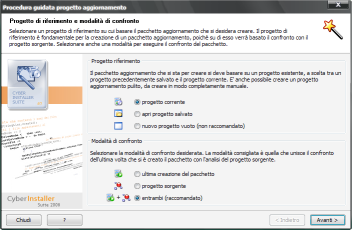![]() CyberInstaller
Studio - 54. Wizard
project update
CyberInstaller
Studio - 54. Wizard
project update
Clicking on the menu File/New/"Project Upgrade Wizard or by using the model" Patch Package "from the window "New Project" opens the window" Project Update Wizard, which will create a project update by a wizard that will assist you in 6 easy steps, the rapid creation of an installation package that will update a previous package installed.
Although you can create an upgrade package without going through this wizard, the use of this wizard is especially recommended for less experienced users, since it will create a working package quickly and safely. After using the wizard, once the project with the new settings will be created, you can use at any time CyberInstaller Studio for editing using full potential. The wizard is still recommended even for experienced users to create a working package in a few seconds.
This tool is also activated at any time by simply pressing keys <Ctrl + U>.
![]() CyberInstaller
Studio - 54.1. Wizard project update - Arrangements for the overall
operation
CyberInstaller
Studio - 54.1. Wizard project update - Arrangements for the overall
operation
An upgrade package is nothing but a setup package next to a main installation package, used to update certain principal components of the installation. Let's say you installed a software that, like CyberInstaller Suite, consists of several modules (applications) and various components-dependencies for the functioning of all modules, plus an online help and multimedia files (graphics, sounds, video, etc..). The user will install the main package and its operation will ensure the effectiveness of installing CyberInstaller, then everything will work perfectly, despite the complexity of the package. Subsequently, the manufacturer of the software creates an update to a single module of the software suite (eg, online help, an executable, adding a vital component, some icons, etc..). If you distribute a new package of "standard" installation, the end user should remove the previous package Then reinstall the new, with a huge waste of time because the file is expected to update only one or a few others. Creating a package update instead CyberInstaller Studio will understand automatically analyzes the project source and compared it with the current main installation package, which files have changed and the package insert only the updated files. Eg, a simple recompilation of the executable, change the file icon, adding component-dependencies necessary executable update, change a few pages of the manual and maybe the addition of other pages, will ensure that those files, and only these (ie the only files modified or added) are added to the installation package upgrade. The end user, therefore, can use this package only if the main package (and software) has already been installed (otherwise the parties would not be out of date software is installed), looks to be automatically detected CyberInstaller (which will stop the installation by informing the user where appropriate). If the main package has been installed, installing the upgrade package will spin smooth and will update only those files that are added to the package (so only those actually changed since the last installation of that software).
Use of an upgrade package so
will benefit both the developer is the end user: the developer because
it will create a package with only updated files (modified or added) to
the end user because he has to do with a package size significantly
lower than the complete installation and will not uninstall anything
before starting the upgrade package, which thinks in a completely
automatic with all modifications to be done primarily by the
installation above.

Note:
Whether you create an installation package update that standard, the files
on the target system will be upgraded only if their version will be
lower than the same files in the installation package, or if their date
of creation will be older. The copy mode defined in
step "File Details" always
defines how we will possibly overwrite the files. No files will be
overwritten when the copy mode settings for that particular file is not
met.
![]() CyberInstaller
Studio - 54.2. Wizard project update - Step 1: Project reference and
comparison mode
CyberInstaller
Studio - 54.2. Wizard project update - Step 1: Project reference and
comparison mode
 The first step of the
wizard project update:
Project reference and
comparison mode.
The first step of the
wizard project update:
Project reference and
comparison mode.
Here you can specify exactly how to behave CyberInstaller Studio then automatically create the upgrade package, with only files added or changed compared to the main installation package (called "Project reference").
Project reference
Current Project
Use as reference design the project currently open with CyberInstaller Studio. It's for their advice not to risk mistakes and do not want confrontation with projects.
Open saved project
![]() CyberInstaller
Studio - 54.3. Wizard project update - Next Steps
CyberInstaller
Studio - 54.3. Wizard project update - Next Steps
The next steps in the "Wizard project updates" are in all respects similar to those of the "New Project Wizard." Some will vary according to the choices listed in the first step (ie if you do not choose as a way to compare what covers the analysis of the source project, this will not be required). Then, see the "Application Wizard" for more details.
![]() See
also ...
See
also ...